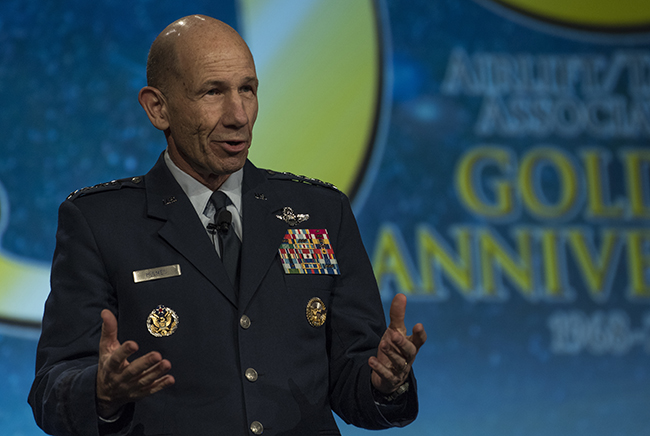
Air Combat Command boss Gen. Mike Holmes speaks at the Airlift/Tanker Association Symposium in Grapevine, Texas, on Oct. 27, 2018. Air Force photo by TSgt. Jodi Martinez.
Air Force Air Combat Command chief Gen. Mike Holmes argues the service can spend $1 billion researching and developing Next-Generation Air Dominance solutions despite some lawmakers’ doubts the money can be used in a timely and effective way.
Holmes, one of the most senior officials with a stake in NGAD, said he is meeting with congressional staffers during August recess to convince them to pass legislation with full funding for the forward-looking combat technology program. House lawmakers propose slashing fiscal 2020 funding for NGAD from $1 billion to $500 million due to “cost risk associated with development,” according to the House-passed version of the 2020 defense policy bill.
“We think that money can be spent effectively and well in developing options for the future,” Holmes said at an Aug. 20 Defense Writers Group breakfast. “I’m meeting routinely with professional staffers during the recess and trying to work through getting to the right answer for the country.”
NGAD is an overarching, largely classified effort looking at a range of technologies to ensure the US controls the skies in combat into the 2040s. The Air Force has said it will need to supplement its F-22 and F-35 fifth-generation fighters with additional stealthy assets by the 2030s, but are more broadly looking at a “family of systems” that offer air superiority instead of pursuing one specific, new platform.
Despite adversaries’ growing air defenses, he believes the Air Force will still need platforms that can reach in close to enemy targets. NGAD is one element of how the service can evade improving enemy air defenses, he added.
A senior Air Force official told Air Force Magazine that the $500 million-even reduction suggests NGAD money is being shifted to pay for another need.
“Usually when it’s something like $412.8 million, that’s traceable to a specific thing,” the official said. “When it’s a round number like that, they’re just chopping to pay for something else.”
Holmes believes lawmakers likely have “some skepticism about the slope of the increased spending” on NGAD.
“Historically, programs tend to under-execute a little bit for a variety of reasons, including, when does the (National Defense Authorization Act) actually get signed, and when does the money actually become available to be committed into contracts” Holmes said.
Falling short of expectations can also become a “self-fulfilling prophecy,” he added.
“We’re going to continue to work through it,” Holmes said. “We do think it’s an important capability, we think the entire force depends on it, we feel responsible for it, and so we’re going to keep advocating for it.”
Elsewhere in the upcoming budget, Holmes said the Air Force will have to make “hard choices” to discontinue some of its missions.
As the service confronts a smaller-than-desired budget, senior leaders are looking at what can be cut in the coming years. Lawmakers are working on a federal 2020 budget with a defense topline of $738 billion—down from the requested $750 billion—followed by $740 billion in 2021.
Holmes declined to discuss what changes may be on the table.
“(Air Force Chief of Staff Gen. David Goldfein) is working through the process right now of deciding what those hard choices will be,” Holmes said. “We’ll look at things that maybe people count on us to do, but maybe aren’t as important as other things.”
